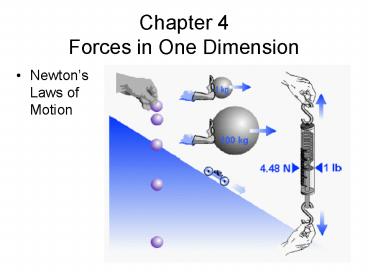Chapter 4 Forces in One Dimension - PowerPoint PPT Presentation
1 / 15
Title: Chapter 4 Forces in One Dimension
1
Chapter 4Forces in One Dimension
- Newtons Laws of Motion
2
Force is the action which has the ability to
change motion.
- Objects need a force applied to them in order to
change their motion.
- A force is also called a push or a pull.
Sir Issac Newton described three Laws that govern
motion.
3
- Force is measured in Newtons (N) in the metric
system. - 1 N 1 kgm/s2
- The English unit for force is a pound (lb).
- 4.48 N 1 lb
- Forces are vector quantities and can
- be denoted with arrows because you
- can push in specific direction.
4
Force diagrams Four types of forces can act on
an object
Fn normal force. This is the support force that
objects resting on each other exert.
Fa applied
force This is the force that is being applied to
the object. It always acts like it comes out of
the center of mass
Ff frictional force This is a force that
happens whenever two surfaces touch. This force
will always oppose the applied force.
Weight Fg Gravitational force This is the force
created because of gravity pulling on the mass of
the object.
5
What if forces are balanced?Newtons First Law
of Motion
- An object at rest stays at rest or an object in
motion stays in motion (constant velocity) unless
acted on by an unbalanced (net) force. - It is also known as the law of inertia
- Inertia an objects ability to resist a change in
motion.
INERTIA
Example The man pushed the cart in order to
make it roll. The bigger the cart the harder
the man must push
6
What if forces are unbalanced?Newtons Second
Law of Motion
- If an unbalanced (net) force is applied to a mass
it will accelerate. - The mathematical relationship between
acceleration and mass is directly proportional
and inversely proportional to force. A math
formula can be written - F m a
- F force
- m mass
- a acceleration
F m x a
What is mass?
The amount of stuff (atoms) in an object
7
You try!
Example The man pushed the cart with 10 N of
force to make it accelerate 20 m/s2. What was the
mass of the cart? See if you can
calculate the mass.
F a m
10 N
20 m/s2
0.5
kg
?
8
What if forces are unbalanced?
Tracker A is pulling on the 10 kg block with a
force of 50 N and tracker B is pulling on the
block with 20 N. How fast is the block
accelerating and in what direction?
F m a
30 N
Remember your vector rules
10 kg
Net Force 50 N 20 N 30 N
?
3 m/s2
9
Remember what happens if all four forces are
balanced?
The object is standing still or moving at a
constant velocity!
10
Weight and Gravity
- Gravity is the rate at which all things fall to
the earth. - It is always 9.8 m/s2
- Weight is a measure of how gravity pulls on your
mass to create a downward force. - Your weight can be calculated just like any other
force is calculated. Fw weight - m mass
- g gravity
Notice that gravity is an acceleration value
Fw mg
g 9.8 m/s2
Air resistance is friction for falling objects.
Air resistance is why it seems like things fall
at different rates.
All things fall at this rate no matter what their
size!!!!
11
Remember the things that effect gravity are
- The size of the mass.
- The bigger the mass the greater the gravitational
pull. - The distance between the masses.
- The farther apart two masses, the less
gravitational force is felt between
them.
12
Weight vs. Mass
- Your mass is constant because it is a measure of
the amount of atoms in your body. - Your weight will change if the gravity of the
planet changes.
Since Mars is a smaller planet, it will have a
smaller gravity and pull down on a mass with less
force.
13
Forces come in pairsNewtons Third Law of Motion
- For every action there is an equal and opposite
reaction. - These forces always occur in pairs and are often
called action-reaction forces. - Remember if forces are equal, what is happening
to the object?
EQUAL and OPPOSITE REACTIONS
They are standing still or moving at constant
velocity.
Action The boy threw the ball forward with a
certain amount of force
Reaction The boy rolled backward with the same
amount of force
14
Momentum An objects tendency to continue with a
certain motion
- Momentum has to do with collisions and what
happens to motion when objects collide. - The Law of conservation of momentum states that
the amount of momentum after a collision must
equal the amount of momentum before the collision
if no outside forces act on the objects.
15
- You can calculate momentum using this formula
- p momentum
- p mv m mass
- v velocity

